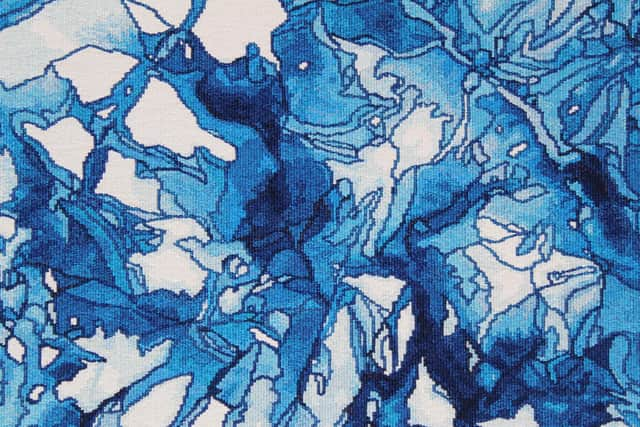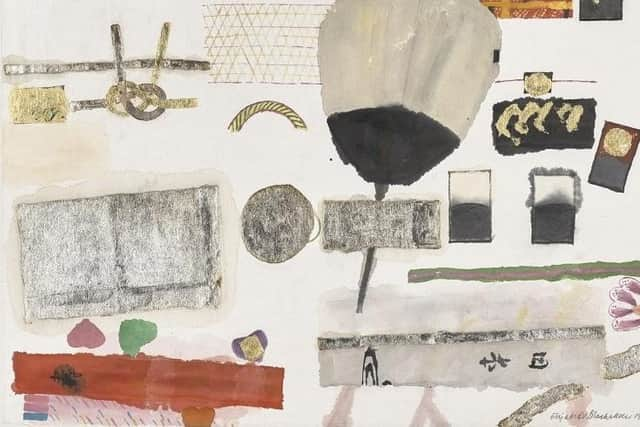Art reviews: Scottish Women Artists: 250 Years of Challenging Perception | Elizabeth Blackadder: A Celebration | A Journey Shared: Elizabeth Blackadder and John Houston
Scottish Women Artists: 250 Years of Challenging Perception, Dovecot Studios, Edinburgh *****
Elizabeth Blackadder: A Celebration, Scottish Gallery, Edinburgh ****
Advertisement
Hide AdA Journey Shared: Elizabeth Blackadder and John Houston, Royal Scottish Academy, Edinburgh ****


Many years ago, a venerable Edinburgh lady told me of a conversation she had had as a girl with Phoebe Traquair. The artist was working on her mural scheme in the Mansfield Place Church, high up on some scaffolding, but after some chat she called down to her visitor to ask the time. When told, she shinned quickly down the ladder saying,”Oh dear! I must go home to finish turning the collar on one of my husband’s shirts.” Her husband’s shirts apart, Traquair’s needlework is stunning, as indeed is all her craftsmanship. In Scottish Women Artists: 250 Years of Challenging Perception, put on by the Fleming Collection at Dovecot Studios, there is a drawing for one of her major needlework pieces together with a full-size reproduction of the finished work. She was very versatile though, and there is also an exquisite miniature of her daughter Hilda, aged five. Traquair was an artist and a mother, but the story about her husband’s shirts does illustrate the dilemma that domestic expectations created for women who were artists, even the most successful.
Thus Dame Ethel Walker’s declaration in 1938 that “There is no such thing as a woman artist. There are only two kinds of artists – bad and good,” has to be qualified. The word should be gender neutral, certainly, but the wider point of this excellent show seems to be that the story of the struggles specific to women artists needs nevertheless to be told. Sometimes the effect of this struggle was insidious, but at other times it was blunt. When Dorothy Johnstone, one of the most brilliant artists of the first decades of the last century, married, she had to give up her post at Edinburgh College of Art. Without that vital link with her professional community, her inspiration faded. Her friend Cecile Walton’s career suffered similarly though in different circumstances. Nevertheless, from happier times, Dorothy Johnstone’s portrait of Cecile, reclining in a haystack in striped pantaloons, is one of the stars of the show. Cecile’s own art is represented by a self-portrait. She’s asleep, but about to be woken by her little son brushing her hair. With this exquisite image of maternal intimacy she declares roundly that she, too, is both artist and mother.
Anne Redpath, however, a student at ECA when Dorothy Johnstone was still teaching there, set her art aside for her family, but later triumphantly reclaimed her position as a leader in the Scottish artistic community. She is represented here by a beautiful earlier landscape and by the characteristic Still Life with Orange Chair from the 1940s. Things were shifting too, if glacially. Redpath was the first woman painter to be elected to the RSA, only preceded by the sculptor Phyllis Bone, represented here by two characteristic small bronzes of animals. Also with an animal subject, her contemporary Agnes Miller Parker’s The Uncivilised Cat is a cubist masterpiece from 1930. There are continuities too. Elizabeth Blackadder and John Houston lived in a flat below Redpath for seven years. You can see how the two women shared a sensibility when you move from Redpath’s orange chair to Blackadder’s Flowers on a Red Table.
These women were pioneers, but their antecedents nevertheless go way back. The show begins with engravings of works by Catherine Read, a successful portrait painter in the 18th century. From the next century, one of the most striking images here is a painting of a gull’s nest by Jemima Blackburn. It is in oil, but she was discouraged from exhibiting by some crassly patronising remarks from Ruskin and so is best known for her watercolours. Most of the show is from the Fleming Collection, but this and one or two other pictures are loans.


Standard bearer for a new generation of women, Bessie McNicol is represented here by several pictures including her portrait of her friend and contemporary EA Hornel. One of the most promising talents of her time, tragically she died in childbirth. Joan Eardley eschewed domesticity entirely, but was cruelly then killed by breast cancer. She is represented here by a wonderful small painting of a rag and bone shop, one of her magnificent Catterline seascapes and a tapestry of a Catterline landscape. A distinctly modernist painting of harvesters by Millie Frood represents the talented women in the New Scottish Group, formed in wartime Glasgow. There was also the inspiring presence in Glasgow in the 1940s of Jewish refugee artists like Josef Herman and Jankel Adler, who brought with them the inspiration of modernist art in Europe as well as strongly left-wing views. These people together provided much inspiration to Eardley and artists like Bet Low, who is not represented here.
Advertisement
Hide AdAs well as Blackadder, her contemporary Frances Walker is represented with a lovely, big painting of Tiree. In the next generation Victoria Crowe is principally represented by a tapestry of Venice, but there is also work by Sam Ainsley, Kate Downie, Joyce Cairns and other contemporaries. The Fleming Collection keeps up to date, too, with amongst other recent additions several of Sekai Machache’s beautiful photographic prints.
Blackadder features again, not once but twice, in other current exhibitions. Elizabeth Blackadder: A Celebration is at the Scottish Gallery while at the RSA, A Journey Shared is a joint show of Blackadder with her husband John Houston. The Scottish Gallery show is divided between oil painting and watercolours and includes a wide range of work in the latter medium. The RSA exhibition is more chronological and includes some of Blackadder’s lovely early drawings. Houston’s work is often explosive. Blackadder herself said how his example pushed her to be more adventurous, but what is striking about her work in both shows is how bold she could be from the very start: in the Scottish Gallery, for instance, Still-Life with a Pineapple from 1963 and Door to a Garden, Vence, from 1966, or Still-Life with Silk Scarf from 1968 at the RSA – all fizz with energy and invention. You see this still in paintings like Reflections in a Dark Pool from 1993. Even when she paints something calmer, energy flows through it as in Still Life with Orchid from 1990.
Advertisement
Hide AdHer most familiar work is quieter, however. Pictures like Chinese Still Life at the Scottish Gallery, or White Still Life with Rainbow at the RSA have a kind of poetry that is quite her own. Her watercolours, especially of flowers, and her prints of cats are beautiful and have helped to make her famous, but in these shows we see how much more there was to her work.


Seeing her work alongside Houston’s, the quietness and delicacy of this side of it is in startling contrast to some of his extravagantly coloured, big pictures where, inspired by the America Abstract Expressionists, his handling of paint seems almost violent. But he too could achieve real poetry, especially in some of his smaller watercolours. These shows together give a very rich account of two remarkable artists.
Scottish Women Artists: 250 Years of Challenging Perception until 6 January; Elizabeth Blackadder: a Celebration until 26 August; A Journey Shared: Elizabeth Blackadder and John Houston until 10 September